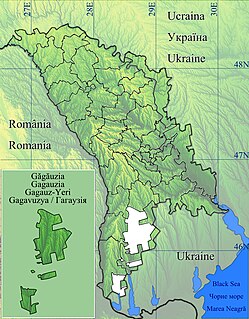
Căușeni is a town and the administrative center of Căușeni District, Moldova.

Cocieri is a commune in the Republic of Moldova, and the administrative center of Dubăsari District. It is located on the eastern bank of the Dniester River, consisting of two villages, Cocieri and Vasilievca.

Giurgiulești is a commune in the Cahul District of Moldova. It is also a border crossing point to Romania, located 10 km (6.2 mi) from Galați.

Coșnița is a commune located in Dubăsari District of the Republic of Moldova, on the eastern bank of the River Dniester. It consists of two villages, Coșnița and Pohrebea.

Gaidar is a commune and village in the Gagauz Autonomous Territorial Unit of the Republic of Moldova. The 2004 census listed the commune as having a population of 4,525 people. Gagauz total 4,368. Minorities included 32 Moldovans, 47 Russians, 25 Ukrainians, 37 Bulgarians and 12 Roma.

Avdarma is a commune and village in the Gagauz Autonomous Territorial Unit of the Republic of Moldova. The 2004 census listed the commune as having a population of 3,564 people. 3,356 of the inhabitants belonged to the Gagauz people; minorities included 47 Russians, 43 Ukrainians, 42 Moldovans, 32 Bulgarians, and 25 Romani people. The History and Ethnography Museum in the village was opened 2011.

Sărata-Galbenă is a commune in Hîncești District, Moldova. It is composed of five villages: Brătianovca, Cărpineanca, Coroliovca, Sărata-Galbenă and Valea Florii. Its existence was first documented in 1609.

Costeşti is a city in Rîșcani District, in northern Moldova.

Baroncea is a commune in Drochia District, Moldova. It is composed of two villages, Baroncea and Baroncea Nouă. At the 2004 census, the commune had 1,609 inhabitants.

Cotova is a commune in Drochia District, Moldova. It is composed of two villages, Cotova and Măcăreuca. At the 2004 census, the commune had 3,569 inhabitants.

Fîntînița is a commune in Drochia District, Moldova. It is composed of two villages, Fîntîniţa and Ghizdita, loc. st.c.f.. At the 2004 census, the commune had 1,405 inhabitants.

Hăsnășenii Noi is a commune in Drochia District, Moldova. It is composed of two villages, Hăsnăşenii Noi and Lazo. At the 2004 census, the commune had 1,736 inhabitants.

Pelinia is a commune in Drochia District, Moldova. It is composed of two villages, Pelinia and Pelinia, loc. st.c.f.. At the 2004 census, the commune had 7,538 inhabitants. Pelinia is the largest commune in Moldova.

Pervomaiscoe is a commune in Drochia District, Moldova. It is composed of two villages, Pervomaiscoe and Sergheuca. At the 2004 census, the commune had 897 inhabitants.
Șuri is a commune in Drochia District, Moldova. It is composed of two villages, Șuri and Șurii Noi. At the 2004 census, the commune had 4,614 inhabitants.

Palanca is a commune in Drochia District, Moldova. It is composed of three villages: Holoșnița Nouă, Palanca and Șalvirii Noi. At the 2004 census, the commune had 901 inhabitants.

Trușeni is a commune in Chișinău Municipality, Moldova. It had a population of 7,952 at the 2004 Moldovan Census, and is a northwest suburb of the city. The commune is composed of two villages, Dumbrava and Trușeni.

Cosăuți is a commune in Soroca District, Moldova. It is composed of two villages, Cosăuți and Iorjnița. The commune is located on the Moldovan border with Ukraine, near the city of Yampil.

Copceac is a commune and village in the Gagauz Autonomous Territorial Unit of the Republic of Moldova. The 2004 census listed the commune as having a population of 9,551 people. Gagauz total 9,068. Minorities included 110 Moldovans, 97 Russians, 71 Ukrainians, 144 Bulgarians and 33 Roma.
According to the Moldovan law on territorial administrative organisation, two or more villages can form together a commune.









